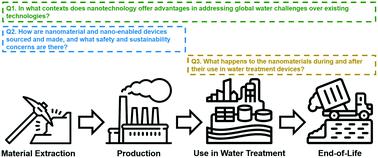当前位置:
X-MOL 学术
›
Environ. Sci.: Nano
›
论文详情
Our official English website, www.x-mol.net, welcomes your feedback! (Note: you will need to create a separate account there.)
Doing nano-enabled water treatment right: sustainability considerations from design and research through development and implementation
Environmental Science: Nano ( IF 7.3 ) Pub Date : 2020-09-28 , DOI: 10.1039/d0en00584c M. M. Falinski 1, 2, 3, 4, 5 , R. S. Turley 1, 2, 6, 7, 8 , J. Kidd 1, 2, 9, 10, 11 , A. W. Lounsbury 1, 2, 3, 4, 5 , M. Lanzarini-Lopes 1, 2, 9, 10, 11 , A. Backhaus 1, 2, 3, 4, 5 , H. E. Rudel 1, 2, 3, 4, 5 , M. K. M. Lane 1, 2, 3, 4, 5 , C. L. Fausey 1, 2, 3, 4, 5 , A. C. Barrios 1, 2, 9, 10, 11 , J. E. Loyo-Rosales 1, 2, 12, 13, 14 , F. Perreault 1, 2, 9, 10, 11 , W. S. Walker 1, 2, 7, 15, 16 , L. B. Stadler 1, 2, 12, 13, 14 , M. Elimelech 1, 2, 3, 4, 5 , J. L. Gardea-Torresdey 1, 2, 6, 7, 8 , P. Westerhoff 1, 2, 9, 10, 11 , J. B. Zimmerman 1, 2, 3, 4, 5
Environmental Science: Nano ( IF 7.3 ) Pub Date : 2020-09-28 , DOI: 10.1039/d0en00584c M. M. Falinski 1, 2, 3, 4, 5 , R. S. Turley 1, 2, 6, 7, 8 , J. Kidd 1, 2, 9, 10, 11 , A. W. Lounsbury 1, 2, 3, 4, 5 , M. Lanzarini-Lopes 1, 2, 9, 10, 11 , A. Backhaus 1, 2, 3, 4, 5 , H. E. Rudel 1, 2, 3, 4, 5 , M. K. M. Lane 1, 2, 3, 4, 5 , C. L. Fausey 1, 2, 3, 4, 5 , A. C. Barrios 1, 2, 9, 10, 11 , J. E. Loyo-Rosales 1, 2, 12, 13, 14 , F. Perreault 1, 2, 9, 10, 11 , W. S. Walker 1, 2, 7, 15, 16 , L. B. Stadler 1, 2, 12, 13, 14 , M. Elimelech 1, 2, 3, 4, 5 , J. L. Gardea-Torresdey 1, 2, 6, 7, 8 , P. Westerhoff 1, 2, 9, 10, 11 , J. B. Zimmerman 1, 2, 3, 4, 5
Affiliation

|
Currently, over a billion people around the world lack access to clean drinking water, industrial wastewater treatment and reuse is limited, and conventional water treatment systems cannot adequately treat all contaminants of concern. Nanotechnology-enabled water treatment (NWT) has begun to emerge as a viable option to address many of the problems facing the water treatment status quo, either through cost reducing performance enhancements or filling unmet niches. Advancements in fundamental nanoscience allow unprecedented use of catalysis and energy from across the broad electromagnetic spectrum, as well as unique physicochemical properties, to purify drinking water, treat industrial wastewater, and access unconventional water supplies. However, before fully adopting NWT, it is imperative that the devices are both safe and sustainable, enhancing acceptance from consumers, government, non-government organizations, and industry. We suggest that we are in a unique window of time to “do nano right” by making key sustainability considerations very early in nano-water technology development. To this end, we have developed a framework based on three guiding research questions aimed at understanding the breadth of sustainability considerations for NWT at each of the four major life cycle stages – extraction, production, use, and end-of-life. In following this framework, researchers and product developers can design nano-enabled water treatment devices that perform well and are both safe and sustainable. By presenting the current state of sustainable NWT and specifying gaps in the literature, the present review aims to further develop NWT to be the best alternative to conventional water treatment across a variety of sectors.
中文翻译:

正确地进行纳米水处理:从设计,研究到开发和实施的可持续性考虑
当前,全世界有超过十亿人无法获得清洁的饮用水,工业废水的处理和再利用受到限制,并且常规的水处理系统无法充分处理所有令人关注的污染物。启用纳米技术的水处理(NWT)已经成为解决水处理现状所面临的许多问题的可行选择,无论是通过降低性能的提高成本还是填补未满足的需求。基础纳米科学的进步允许空前广泛地利用广泛电磁谱中的催化和能量以及独特的理化特性,以净化饮用水,处理工业废水并获得非常规的供水。但是,在完全采用NWT之前,必须确保这些设备既安全又可持续,增强消费者,政府,非政府组织和行业的接受度。我们建议我们在纳米水技术开发的早期阶段就关键的可持续性考虑因素,处于“做到纳米权”的独特时间窗口中。为此,我们基于三个指导性研究问题开发了一个框架,旨在理解NWT在四个主要生命周期阶段(提取,生产,使用和报废)中可持续性考虑因素的广度。按照此框架,研究人员和产品开发人员可以设计出性能良好且安全且可持续的纳米级水处理设备。通过介绍可持续NWT的现状并指出文献中的空白,
更新日期:2020-11-03
中文翻译:

正确地进行纳米水处理:从设计,研究到开发和实施的可持续性考虑
当前,全世界有超过十亿人无法获得清洁的饮用水,工业废水的处理和再利用受到限制,并且常规的水处理系统无法充分处理所有令人关注的污染物。启用纳米技术的水处理(NWT)已经成为解决水处理现状所面临的许多问题的可行选择,无论是通过降低性能的提高成本还是填补未满足的需求。基础纳米科学的进步允许空前广泛地利用广泛电磁谱中的催化和能量以及独特的理化特性,以净化饮用水,处理工业废水并获得非常规的供水。但是,在完全采用NWT之前,必须确保这些设备既安全又可持续,增强消费者,政府,非政府组织和行业的接受度。我们建议我们在纳米水技术开发的早期阶段就关键的可持续性考虑因素,处于“做到纳米权”的独特时间窗口中。为此,我们基于三个指导性研究问题开发了一个框架,旨在理解NWT在四个主要生命周期阶段(提取,生产,使用和报废)中可持续性考虑因素的广度。按照此框架,研究人员和产品开发人员可以设计出性能良好且安全且可持续的纳米级水处理设备。通过介绍可持续NWT的现状并指出文献中的空白,


























 京公网安备 11010802027423号
京公网安备 11010802027423号